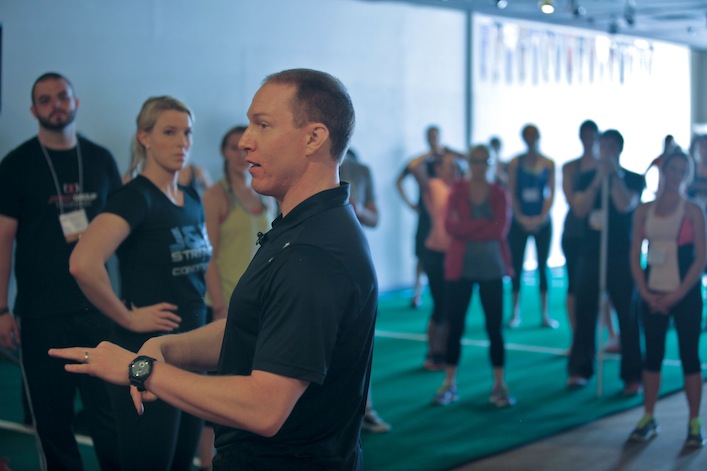Learning From the Best
A couple years ago, Seth Godin put out an awesome book called Tribes: We Need You To Lead Us. In it he talks about becoming a leader in your field, building a following, and share information effectively. Depending on what you’re interested in, odds are you have specific people you go to for specific information. Let’s say I’m your go-to guy for strength training and corny jokes, whereas you would go to someone else for info on wine pairings that work best with different chicken dishes. Another person might be the best source for late night comedy, but no one person is going to be everything to everyone.
You can bet I place a high emphasis on some members of the strength and fitness community, as the information they share is directly relevant to the training I use, as well as the applicability to my clients and their specific concerns. Mike Robertson is one of those guys. He runs a site RobertsonTrainingSystems.com and puts out nothing but high quality information all the time. He’s put out some amazingly epic posts, like his 10,000 word epic on front squats, a similar Magnum Opus on Bench Press, a disgustingly long and detailed pice on Deadlifts, and literally hundreds of others.
One way to expand your network of expert people you can go to for information is to see who the people you currently look to would recommend. Mike teamed up with a guy whom I’d never heard of before, but who has a ton of experience working with high caliber athletes and pro NFL teams in Joe Kenn on his latest video series.
Mike and Joe just released a new video series, Elite Athlete Development Seminar, based on a workshop they hosted a few months ago. I’ve seen Mike present and worked with him on a couple projects, such as Muscle Imbalances Revealed: Lower Body, but I hadn’t had the chance to see Joe speak and lay out the system he uses for training his athletes, and I wanted to speak on that a little bit today because I felt it was really smart and concise.
Joe developed something he calls the Tier System, which works really well with football players, his main area of expertise. Football has a lot of confounding variables, like max power output during a fatigued state, rapid recovery and high degrees of agility. Training any one of these systems by themselves are fine, but at any given time, an athlete will need them all at once on the field.
A big aspect he discusses is balancing the stress of the sport with the stress of the weight training. In his world, athletes are not paid or get spots on the team based on how much weight they move int he gym, but on how they perform on the field, and the strength program can’t take away from that. Additionally, he has some awesome one-liners, such as “I don’t let guys sit down between sets because I don’t want to train bench warmers,” and “no one cares how big your arms are if you’re getting stapled to the turf.”
The Tier system used components from olympic lifting, strongman, powerlifting (aspects from Westside Barbell methods), as well as systemic isolation concepts like training the posterior chain, elbows knees and neck, and variations in workload & exercise order to make absolute beasts in the gym.
The Tier System comes down to what is prioritized highest that day, whether it’s Total Body movements, Lower Body movements or Upper Body movements, and cycled throughout the week. You’re going to be training everything each day, but emphasizing some aspects more than others on each separate day. The primary focus on one day may be a secondary or tertiary focus on other days, but it gets cycled to allow for stress and recovery in order to keep athletes on the field and getting stronger concurrently.
When I saw Joe present on his Tier System, it looked like a combination of a lot of different types of periodization concepts I’ve seen, but instead of being ridiculously specified, it made it very simplified and easy to follow. I like that, and I think it’s something that can make a huge lightbulb moment for a coach or trainer looking to understand how to structure a training program effectively to attack a lot of competing aspects of training at the same time.
Before Joe’s first presentation, Mike touched on a system for coaching he uses with a bunch of athletes in different sports and activities, as well as with his general population clientele. He calls it the R7 Approach, which stands for “Release, Reset, Readiness, Reactive, Resistance, Regenerate, Recover,” and he outlines some of the finer points of it in this post HERE.
Having had the privilege to work with some of Mike’s clients both in person and through distance coaching, I can say that it helps structure a program very effectively to cover a lot of different bases on a daily basis, without getting carried away on any one or two elements. I couldn’t imagine spending an hour on foam rolling or how dead you would be after working on reactive training for an entire session without switching to something else, so having a solid flow to it makes life a lot easier for the coach, but the biggest benefit as Mike states is getting the athlete to buy in to the program and having them do all the work outside of their normal session, such as the Release and Recover work.
The benefit to either system isn’t to what exercises are used or how they’re coached, but in the systematic method used to put together the programs to address the needs of the individual in front of them, and to allow for a simplified manner of coding to see what the intent should be and what should be done next.
Elite Athlete Development Seminars is a great video series for any coach, trainer, or individual who works in the fitness industry to help them teach their clients and athletes in a more systematic manner that can help streamline program writing and addressing multiple concerns. For the more hardcore fitness enthusiast out there who prides themselves on knowing how to do things like program their own workouts and cycle their training stressors versus just doing nothing but 1RM bench every day, it’s an awesome resource to get very effective yet stripped down systems of training design that they can use for themselves and maybe even the teams they train with to help everyone get stronger and faster, without destroying themselves.
Here’s a small sampling in what’s in the course:
– Critical approach to make sure all of your programming bases are covered
– How to develop programs that address multiple physical qualities (i.e. speed, power, strength, conditioning, etc)
– Where most programs fail miserably – and what you can do to avoid it
– A “behind-the-scenes” look at real programs, designed by real coaches, No theory and conjecture here, just the good bad and the ugly behind real world programs
– A step-by-step process on how to build complex programs. Chasing one physical capacity is easy, but how do you address multiple factors without killing your athletes?
– How to organize daily and weekly training sessions for maximum success
– The evolution of Joe Kenn’s Tier System, and how he’s using it today to build elite athletes
– 6 factors for coaching success
Mike and Joe are two of the best in the business, and I absolutely believe that this will become required viewing for any strength coach and trainer in the next few years because it covers so much ground in such a straight forward manner. They just released it today and it’s on a launch sale price for $150 off the regular price for the entire 15 hours of video for only $199, ending Friday evening.
If you’re serious about coaching and getting better with your programming and delivery, this is an absolute game changer. I’ve already started to use some of the concepts in my current programming with my own clients, as well as my own training, and love how simple it can be to quickly and effectively put together awesome programs.


